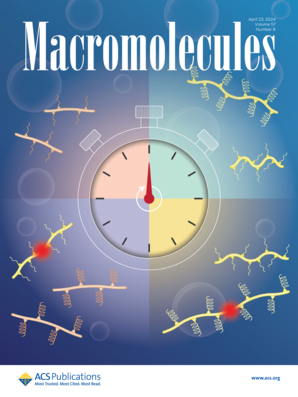超薄膜中等规聚丙烯β-与α-晶体生长速率比的膜厚依赖性
IF 5.1
1区 化学
Q1 POLYMER SCIENCE
引用次数: 0
摘要
以往对等规聚丙烯(iPP)的研究表明,由于β-iPP的表面动力学更快,当结晶温度(Tc)介于临界温度下限(Tc** ~ 100℃)和临界温度上限(Tc* ~ 141℃)之间时,生长速率β与α相之比(Gβ/Gα)超过1。然而,在这项工作中,我们观察到当膜厚度(d)从24 nm减小到9 nm时,Gβ/Gα >;1变窄甚至消失,因为Tc*逐渐向更低的温度转移,而Tc**保持不变。这可能是由于随着d的减小,β-iPP的耗散带宽度(wd)比α-iPP的耗散带宽度(wd)扩大得更明显,导致β-iPP向生长锋的扩散速度变慢。因此,随着d的减小,Gβ的减小幅度大于Gα,导致Gβ/Gα值的减小,特别是在较高的Tc时,Gβ/Gα小于1。此外,我们发现在一定的d下,β-iPP的扩散活化能(Eaβ)始终大于α-iPP的扩散活化能(Eaα),并且随着d的减小,α-iPP与α-iPP之间的差距增大。这进一步表明,随着d的减小,β-iPP的缓慢扩散过程逐渐成为影响Gα和Gβ差异的主要因素。本文章由计算机程序翻译,如有差异,请以英文原文为准。

Film Thickness Dependence of the Growth Rate Ratio of the β- to α-Crystal of Isotactic Polypropylene in Ultrathin Films
Previous research studies on isotactic polypropylene (iPP) have shown that the ratio of growth rate β to α phase (Gβ/Gα) exceeds 1 when the crystallization temperature (Tc) is between the lower and upper critical temperature limits (Tc** ∼ 100 °C and Tc* ∼ 141 °C, respectively), due to the faster surface kinetics of β-iPP. However, in this work, we observed that when the film thickness (d) decreases from 24 to 9 nm, the temperature interval of Gβ/Gα > 1 narrows and even disappears, as Tc* gradually shifts to lower temperatures while Tc** remains constant. This is presumably because, as d decreases, the width (wd) of the depletion zone of β-iPP expands more significantly than that of α-iPP, resulting in slower diffusion toward the growth front of β-iPP. Consequently, Gβ decreases more than Gα as d diminishes, leading to a reduction in the value of Gβ/Gα, especially at higher Tc, where Gβ/Gα becomes less than 1. Moreover, we found that the diffusion activation energy (Eaβ) of β-iPP is consistently greater than that of α-iPP (Eaα) at a given d, and the gap between Eaα and Eaβ increases as d decreases. This further highlights that the slower diffusion process for β-iPP progressively becomes the main factor affecting the difference between Gα and Gβ as d diminishes.
求助全文
通过发布文献求助,成功后即可免费获取论文全文。
去求助
来源期刊

Macromolecules
工程技术-高分子科学
CiteScore
9.30
自引率
16.40%
发文量
942
审稿时长
2 months
期刊介绍:
Macromolecules publishes original, fundamental, and impactful research on all aspects of polymer science. Topics of interest include synthesis (e.g., controlled polymerizations, polymerization catalysis, post polymerization modification, new monomer structures and polymer architectures, and polymerization mechanisms/kinetics analysis); phase behavior, thermodynamics, dynamic, and ordering/disordering phenomena (e.g., self-assembly, gelation, crystallization, solution/melt/solid-state characteristics); structure and properties (e.g., mechanical and rheological properties, surface/interfacial characteristics, electronic and transport properties); new state of the art characterization (e.g., spectroscopy, scattering, microscopy, rheology), simulation (e.g., Monte Carlo, molecular dynamics, multi-scale/coarse-grained modeling), and theoretical methods. Renewable/sustainable polymers, polymer networks, responsive polymers, electro-, magneto- and opto-active macromolecules, inorganic polymers, charge-transporting polymers (ion-containing, semiconducting, and conducting), nanostructured polymers, and polymer composites are also of interest. Typical papers published in Macromolecules showcase important and innovative concepts, experimental methods/observations, and theoretical/computational approaches that demonstrate a fundamental advance in the understanding of polymers.
 求助内容:
求助内容: 应助结果提醒方式:
应助结果提醒方式:


